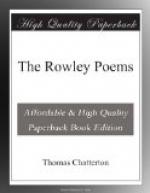Dodsley having failed him, Chatterton next took the bolder step of writing to Horace Walpole, who must have been much in his mind for some years before his sending the letter. Some one has made the ingenious suggestion that a consideration of Walpole’s delicate connoisseurship sensibly coloured Chatterton’s account of the life of Mastre William Canynge. More than this, his delight in the Mediaeval—the Gothic—and his content with what may be termed a purely impressionistic view of the past, was singularly akin to the Bristol poet’s own outlook on these matters. Walpole had further some three years before this time indulged in the very harmless literary fraud of publishing his Castle of Otranto as a translation from a mediaeval Italian MS., only confessing his own authorship upon the publication of the second edition. To Walpole then Chatterton addressed a short letter enclosing some verses by John a Iscam and a manuscript on the Ryse of Peyncteyning yn Englande wroten by T. Rowleie 1469 for Mastre Canynge[5] with the suggestion that it might be of service to Mr. Walpole ’in any future edition of his truly entertaining anecdotes of painting.’ This drew from the connoisseur one of the politest letters[6] that have been written in English, in which the simple and elegant sentences expressed with a very charming courtesy the interest and curiosity of its author. He gave his correspondent ‘a thousand thanks’; ‘he would not be sorry to print’ (at his private press) ‘some of Rowley’s poems’; and added—which reads strangely in the light of what follows—’I would by no means borrow and detain your MS.’ Now Chatterton’s Peyncteyning yn Englande is the clumsiest fraud of all the Rowley compositions, with the single exception of a letter from the secular Priest which exhibits the exact style and language of de Foe’s Robinson Crusoe.[7] Professor Skeat has pointed out that the Anglo-Saxon words, which occur with tolerable frequency in the Ryse, begin almost without exception with the letter A, and concludes that Chatterton had read in an old English glossary, probably Somners, no farther than Ah. Walpole however ’had not the happiness of understanding the Saxon language,’ and it was not until after he had received a second letter from Chatterton, enclosing more Rowleian matter both prose and verse, that he consulted his friends Gray and Mason, who at once detected the forgery. If, as seems certain, Elinoure and Juga was among the pieces sent, it was inevitable that Gray should recognize lines 22-25 of that poem as a striking if unconscious reminiscence of his own Elegy in a Country Churchyard. Now Walpole had some years before introduced Ossian’s poems to the world and his reputation as a critic had suffered when their authenticity was generally disputed. Accordingly he wrote Chatterton a stiff letter suggesting that ’when he should have made a fortune he might unbend himself with the studies consonant to




